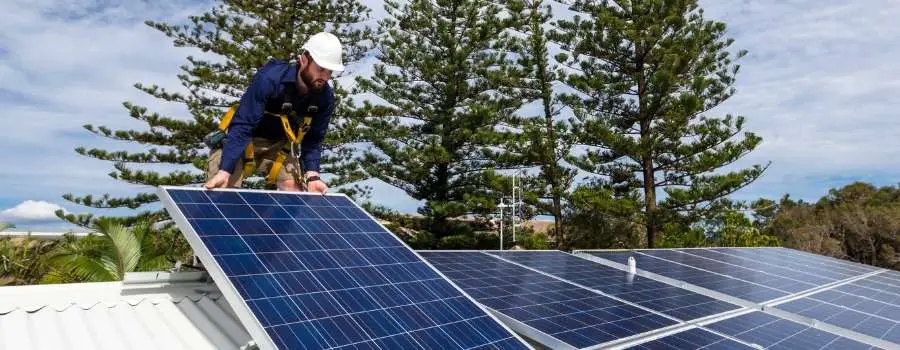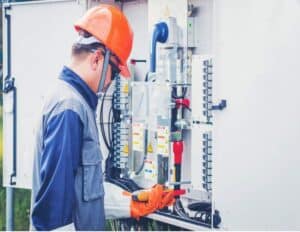
Heating bills can be a veritable nuisance for homeowners during long winter months in North America or Europe, whether you use electricity, gas, oil, or other forms of heating. In some cases like coal or oil, pollution is also a concern.
Heating your home with solar is an exception to this given that it’s naturally available, economical and renewable.
Solar heating does not need to involve the full paraphernalia of solar panels, which could power an entire house if needed. There are a variety of ways to heat your house using solar energy…whether you use active or passive solar power.
Why Solar As A Heat Source
The use of solar power has become popular for off-grid use but also as a way to combine primary and secondary sources, electricity from the grid with the use of solar panels.
The best news is that with reverse metering offered by most utility companies, the excess electricity created by solar can be supplied back to the grid, creating a nice windfall through a rebate back to your utility bill.
Using solar energy to generate electricity or to heat and cool your house should be encouraged for a number of reasons.
Solar Energy Is Free And Abundant
Fossil fuels use fast depleting resources such as uranium, coal, oil, and natural gas…with limitations on both the amounts that can be drawn on over a specific time period and in total over the lifetime of the earth. Renewable resources, such as solar, wind, geothermal, even biomass, are both sustainable and abundant.
Among the renewable sources of energy, the most abundant is solar. The US Department of Energy (1) estimated that the earth receives enough sunshine every minute to fulfill the energy needs of the entire human population for a year. That is the most abundant source of energy available, bar none, including both fossil fuels and renewables.
Having said that, we cannot quite tap every bit of the sun’s rays falling on every inch of the globe. The number of sunny days is an important determination, as is the efficiency ratio in converting solar energy to usable forms for household use.
Not only is solar power free, over time it can pay for the installation and maintenance and possibly make you money. I wrote up an article talking about this over here: Making Money With Solar Power: Here Are 7 Ways
Solar Can Be Installed And Used In Many Ways
With some planning and the right accessories, solar energy can be harnessed via rooftop or ground-level arrays for electricity generation.
An understated model of solar usage, very relevant for solar heating, is the use of solar windows that stay shade-free during peak hours of production, typically 9 AM to 3 PM during the day. The use of south and west-facing windows to concentrate sunlight indoors is a critical step…a SunEye or Solar Pathfinder could be used to identify the areas that need to be kept shade-free.
For more information on installing solar panels at your home, check out this article: 8 Tips To Prepare Your Home For Solar Panels
Solar Is Available Year-Round
Solar energy is available year-round, except in a few areas. This means that even during wintry conditions, you can receive enough sunlight to fulfill your heating needs in most areas.
Even in areas with fewer days of clear sunlight, the ability to use battery stacks to store solar power, or the ability to feed power back to the grid means that you cannot really lose with solar…it’s a net positive effect on your energy systems.
Solar Is A Solid Investment
Study after study has shown that investing in a solar array is a far better proposition, return wise than an equivalent fixed income annuity.
The sources of returns include:
- A first tax year Federal Tax Credit at 26% of the invested amount
- Solar Renewable Energy Credits (SERC) driven revenues
- Other state incentives as applicable
- “Dividend” from energy supplied back to the grid
- Increase in value of a home with an installed solar array
- (In most cases) minimum levels of upkeep, maintenance, and replacement costs
All in, solar is considered to be the least expensive form of energy available on Earth.
Still worried about the setup cost for solar, prices are starting to come down: Will Solar Panels Get Cheaper? Prices Are Trending Down
Solar Can Power Heating And Cooling Systems
Solar energy can be used to power both water and air heaters as well as air conditioners, as covered in this article..
I will describe the options in more detail later, but one of the greatest advancements in recent years has been the emergence of efficient heat pumps. Substantial cost savings can arise from combining solar-derived heat with such appliances.
1. Ensure Your House Is Energy Efficient
Regardless of what form of energy is used, making sure that your house runs on an energy-efficient basis should be a necessary first step.
Install A Smart Thermostat, Smart Appliances, And An Energy Meter
Your local utility may work with you to get a smart thermostat installed and/or give you rebates tied to its use. These super handy devices automatically adjust your temperature settings by a couple of degrees each way to accommodate changes in the temperature inside your house. The end result is not only energy efficient for the power ecosystem, it will save you money.
An energy meter operates on an aligned principle. Its primary purpose is to figure out the loads being drawn by all your appliances. There are a large number of devices and appliances that stay in standby mode at any given hour within an average household…e.g. DVR, microwave, etc. The One-Watt initiative is aimed at ensuring that newer appliances do not draw more than 1 watt while in idle mode.
A smart meter such as the Kill-a-Watt meter would give you continuous readings of power usage so you can address any overuse of power by idling devices. Again, it’s great for the environment and can save you tremendously on your energy bill.
Get An Energy Audit By A Professional

An Energy Audit can be a good early step. It may cost a couple of hundred dollars unless your local utility company offers to do it for free. There are a couple of tests that can be performed to check where the air is escaping through gaps or cracks:
- A basic check of your building envelops to assess insulation levels (the R-value as it’s technically called).
- The more advanced blower door test – where a high-volume fan is used with all windows and doors shut to check where air may be leaking out.
In either case, you will be able to find out the weak points where your insulation may need to be plugged or improved.
Utilize DIY Spot Checks
While a full-blown series of tests may be the way to go, there are some basic checks you should be able to run, given that there are specific areas of a house that typically have issues with insulation – namely the basement, attic, and pipes (such as HVAC system).
- The basement is a great place to start. It may be as simple as carrying a thin sheet of paper (maybe even toilet paper) down, holding it up in the air, and spotting (a) if there is a draft and if so, (b) which direction it’s coming from or blowing towards. Light coming in is another giveaway. Check the pipes as well for leaks.
- The attic must be tackled a bit differently since space is typically outside the HVAC envelope for your house. So what you will be identifying are any possible leakages on the floor of the attic and along the HVAC Ducts – look for drafts and/or build-ups of crust or dust along seams.
How To Plug Gaps And Improve Insulation
There are multiple options that could work on a DIY basis, depending on how extensive the repair needs to be. Options range from:
- Replacing certain frames when necessary.
- Fixes using material such as caulk, foam, or weatherstripping.
- Covering up seams (for example, those around ducts) can be fixed with adhesive materials like mastic and/or different types of tape (e.g., foil-backed or fiberglass) depending on the width of the gap.
Invest In Smart Fixtures
I’ve already mentioned smart appliances that do not create phantom loads by consuming too much energy when idle.
The other easy way to cut down on energy use is by installing smart fixtures – such as LED bulbs and smart fans (that can be used in lieu of an air conditioner under the proper circumstances). Using efficient space heaters and smart humidifiers in conjunction with a ceiling fan will also help by setting up convection currents.
Draw Your Shades Up Or Down At Appropriate Times During The Day
This leads to the next topic, which is how to generate heat through passive solar energy. In terms of the reverse, everyone understands the concept of pulling down the blinds to keep the room cooler during a hot summer day.
Now that the house is in “efficient energy usage mode,” let’s move on to how we can incorporate solar energy into the equation.
2. Invest In Heat Pumps, Radiant Slab Systems, And Heat Storage Tanks
To make the best use of heating systems powered by solar energy, a few pieces of apparatus would greatly enhance the span of influence and efficiency of any solar heating system. Consult with a professional before installing and hooking them up, but consider the following:
Heat Pumps
Heat pumps are a critical accessory. The savings from the system overall in terms of credits and/or savings in energy/fuel costs will more than make up for the initial cost outlay. Heat pumps that may be considered for home use include air heaters and ground heaters.
A typical air-source heat pump can draw air from the heated air and circulate it through use…for this reason, it is an excellent addition to a solar heating system.
In general, the heat pump has an outdoor unit with a coil that can function as a condenser (cooling mode) or evaporator (heating mode), an indoor unit with a matching coil and a fan to move the air, refrigerant, and compressor system to absorb heat and then release it as it circulates, a reversing valve and an expansion valve.
A Radiant Slab or Smart Floor System

A Radiant Slab or Smart Floor are similar systems. The former is a system of empaneled pipes and tubes running behind your walls.
A radiant slab system could also lay the pipes below the floor – this is sometimes referred to as a smart floor. The system is connected to a source of heat, be it solar thermal energy collectors or water heaters in the basement of a house.
While either option can be used to convey heated liquid and radiate heat throughout the house, smart floors are sometimes touted because heat emanating bottom-up is often more comfortable (cold feet, anyone?) and also ideal for setting up convection currents when combined with smart fans.
While there is a natural tendency for heat loss with air circulation, a well-house with a continuous heat source underfoot and convectional currents evenly spreading the heat throughout the house can create a pleasantly warm environment.
(Heat Storage) Water Tank
A water storage tank that is well insulated and therefore capable of holding thermal energy for long periods of time is an essential component of a home heating system…circulating pipes connect inwards to deliver heated water and then are sent out through the house.
A Heat Exchanger System
Heat exchangers are often used in conjunction with other home heating systems to transfer heat from one area to another. With a furnace, for example, flue gas enters and travel through the metal shells and tubes of the heat exchanger. Primary and secondary exchangers will create and utilize both radiant and latent heat to circulate heat through the house.
One concern with heat exchangers used in conjunction with natural gas or propane is the possibility of harmful by-products that people could be breathing in. This danger is significantly reduced with a solar heating system since the hot air running through the heat exchange is clean and not a byproduct of fossil fuel combustion.
Heat exchanges can create a very efficient system in terms of heating the whole house.
These devices may not be required if you are just looking to employ passive solar heating (see below), but they will greatly enhance the use of any active solar heating system.
3. Ready For Solar Energy To Heat The House?
As I mentioned at the start, the sun is a natural source of energy. Photons from the sun’s rays can become involved in different ways to generate heat for the house.
On the one hand, solar panels can generate electricity through a chemical reaction within arrays of photovoltaic cells. This in turn can be used to run appliances and fixtures within the house…which will include heating systems.
On the other hand, there are simpler systems whereas the photons can simply be converted into thermal energy…they do not generate electricity but provide heat within the house.
Here is an article covering more reasons why solar power can be beneficial to you and your home: 7 Reasons Why Solar Power At Home Is Worth It
Active and Passive Use Of Solar Power
Passive
The passive use of solar power uses the principle of shade-free, south and southwest facing, large windows as described above. Besides the natural heating that the specific rooms receive, a few accessories are needed to store the heat and then convey it within the use.
The sun rays can be used to heat either water contained in heat-absorbing containers (e.g., dark-tinted barrels) or an appropriately designed masonry wall or floor.
The heat storage units radiate thermal energy, which initially warms the room but then can be directed towards the rest of the house through convection. In a well-insulated house, which you have prepared already through Step 1 and perhaps with the use of a heat pump (as described in Step 2), the heat can be spread efficiently through a greater part of the home.
Active
Unlike passive solar use, where the devices used to collect and emanate thermal energy are relatively basic, the active use of solar power begins by directing the photons towards a thermal solar energy collector.
The principle is the same as a solar array, except the thermal collectors are not photovoltaic cells that produce free ions that can then be converted into electric current. Instead, the collectors are such that they collect and store a disproportionately large amount of heat as compared to normal containers or surfaces.
Examples of solar energy collectors could be those that contain the following materials:
- Air – Heated air can directly heat up rooms. Alternatively, for broader use, preheated air can be directed to a heat recovery ventilator or heat pump, which then sends warm air onwards to the rest of the house.
- Liquids, such as antifreeze made with diluted non-toxic propylene glycol – This type of solar heater will be connected to a pump that moves the heated liquid from the solar collector through the rest of the house through the system of heating pipes and vents.
Liquid Active Solar
An active liquid solar system operates most efficiently when it is accompanied by some of the critical accessories described under Step 2 above. The liquid from the solar heater is pumped through the pipes or tubes that are part of the radiant slab system (installing below a smart floor has some obvious advantages in terms of a smart floor, as described before) and used to heat multiple rooms.
The heat generated by the solar collectors could also be directed to a hot water storage tank in the basement, which then transfers heat via a heat pump. The system then utilizes hot water radiators, forced-air furnaces, or baseboards to recirculate heat throughout the rooms.
A heat exchanger can also be used effectively to heat water in the house.
Final Thoughts
As I have mentioned in the rest of this article, using solar energy to heat your household during the winter has many benefits. There are multiple ways of utilizing the sun’s rays in the most efficient manner possible.
The scale of deploying the apparatus to capture, store and circulate heat can range from relatively simple arrangements to combinations of solar with other forms of energy. Then, of course, there is a full-scale solar array, which has benefits beyond just heating.
Whatever your approach, the returns will be rewarding for sure. Find out how by contacting your utility company and talk to the solar energy and/or solar heater installer to discover the option that best suits your needs and budget.

